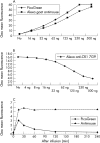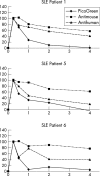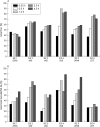First clinical trials of a new heteropolymer technology agent in normal healthy volunteers and patients with systemic lupus erythematosus: safety and proof of principle of the antigen-heteropolymer ETI-104
- PMID: 15308520
- PMCID: PMC1755118
- DOI: 10.1136/ard.2003.016691
First clinical trials of a new heteropolymer technology agent in normal healthy volunteers and patients with systemic lupus erythematosus: safety and proof of principle of the antigen-heteropolymer ETI-104
Abstract
Background: The heteropolymer technology was developed to remove pathogens from the circulation.
Objectives: To evaluate the safety and tolerability of a single administration and to establish proof of principle for ETI-104 in normal healthy volunteers (NHV) and patients with systemic lupus erythematosus (SLE) METHODS: The drug was given intravenously to 11 NHV and six patients with SLE. Over 28 days, vital signs were noted, a haematological and chemical analysis of blood and urine was carried out, and adverse events were recorded. CR1 receptor numbers, the ability of antigen based heteropolymers to bind to red blood cells (RBCs), and the clearance of high avidity and total anti-dsDNA antibodies were measured by Farr assays and FACS analysis.
Results: No safety measure differed significantly from normal in both groups; no drug related serious adverse events occurred. ETI-104 rapidly bound to RBCs in NHV and patients with SLE. Binding of the drug to RBCs of patients with SLE also caused a rapid reduction of circulating anti-dsDNA antibodies in the plasma 15 minutes after administration, with a maximum reduction of 55% (range 43-62). At 28 days statistically significant decreases were maintained in three patients, while in the other three the values had returned to baseline levels.
Conclusion: These clinical trials established the safety and the proof of principle of the new immunoconjugate ETI-104. This provides the basis for further development of this technology for numerous indications-for example, therapeutic options for autoimmune diseases or viral and bacterial infections.
Figures




Similar articles
-
Evaluation of antigen-based heteropolymer for treatment of systemic lupus erythematosus in a nonhuman primate model.Clin Immunol. 2002 Nov;105(2):141-54. doi: 10.1006/clim.2002.5274. Clin Immunol. 2002. PMID: 12482388
-
A bispecific dsDNAxmonoclonal antibody construct for clearance of anti-dsDNA IgG in systemic lupus erythematosus.J Immunol Methods. 2001 Feb 1;248(1-2):125-38. doi: 10.1016/s0022-1759(00)00348-3. J Immunol Methods. 2001. PMID: 11223074
-
Studies on the kinetics of binding of complement-fixing dsDNA/anti-dsDNA immune complexes to the red blood cells of normal individuals and patients with systemic lupus erythematosus.Arthritis Rheum. 1984 Mar;27(3):320-9. doi: 10.1002/art.1780270312. Arthritis Rheum. 1984. PMID: 6546694
-
Clearance of anti-double-stranded DNA antibodies: the natural immune complex clearance mechanism.Arthritis Rheum. 2000 Oct;43(10):2265-75. doi: 10.1002/1529-0131(200010)43:10<2265::AID-ANR14>3.0.CO;2-J. Arthritis Rheum. 2000. PMID: 11037886
-
Clinical significance of antibodies to double stranded DNA (dsDNA) for systemic lupus erythematosus (SLE).Clin Rheumatol. 1987 Jun;6 Suppl 1:56-73. doi: 10.1007/BF02200721. Clin Rheumatol. 1987. PMID: 3304800 Review.
Cited by
-
Have we overestimated the benefit of human(ized) antibodies?MAbs. 2010 Nov-Dec;2(6):682-94. doi: 10.4161/mabs.2.6.13601. Epub 2010 Nov 1. MAbs. 2010. PMID: 20935511 Free PMC article. Review.
-
Antigen-specific immunotherapies in rheumatic diseases.Nat Rev Rheumatol. 2017 Sep;13(9):525-537. doi: 10.1038/nrrheum.2017.107. Epub 2017 Jul 13. Nat Rev Rheumatol. 2017. PMID: 28701761 Review.
-
A transgenic mouse model for studying the clearance of blood-borne pathogens via human complement receptor 1 (CR1).Clin Exp Immunol. 2005 May;140(2):230-40. doi: 10.1111/j.1365-2249.2005.02764.x. Clin Exp Immunol. 2005. PMID: 15807846 Free PMC article.
-
The inhibition of anti-DNA binding to DNA by nucleic acid binding polymers.PLoS One. 2012;7(7):e40862. doi: 10.1371/journal.pone.0040862. Epub 2012 Jul 11. PLoS One. 2012. PMID: 22808279 Free PMC article.
-
Mice expressing human CR1/CD35 have an enhanced humoral immune response to T-dependent antigens but fail to correct the effect of premature human CR2 expression.Immunobiology. 2012 Feb;217(2):147-57. doi: 10.1016/j.imbio.2011.06.001. Epub 2011 Jun 25. Immunobiology. 2012. PMID: 21783272 Free PMC article.
References
Publication types
MeSH terms
Substances
LinkOut - more resources
Full Text Sources
Medical

